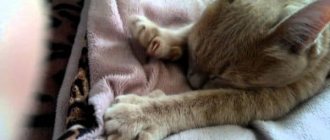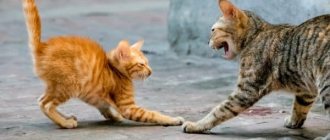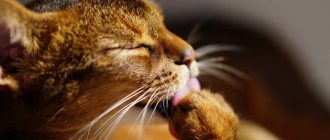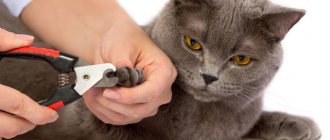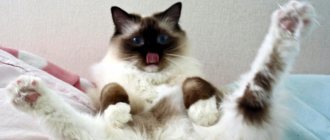Almost every owner who keeps a cat in an apartment knows how many problems can arise from the animal’s sharp claws. If outdoor cats can use tree trunks or wooden fences to sharpen their claws, then pets with their claws spoil the appearance of furniture, carpets, curtains, and wallpaper is literally torn to shreds in some houses. And some pets also love to claw their owners’ arms and legs. In this article, we will look at why cats sharpen their claws, and we will also try to find out whether it is possible to rid pets of this habit.
Why do cats sharpen their claws?
The nature of cats is such that the claws of these graceful animals grow throughout their lives. Gradually, a scaly membrane forms on top of the claws, which causes discomfort in cats. Therefore, they have to periodically grind off this dead stratum corneum. In nature, grinding occurs naturally when the animal climbs trees. At home, cats have to use other available items.
It is also believed that by scratching things, a cat marks them. This happens thanks to the glands located on the animal’s paws. Cats tend to leave these marks when they are stressed, angry, or want to mark their territory to other cats.
My cat is more accustomed to sharpening his claws outside, using poles and trees for this purpose. If the cat is not released outside at his first request, then he begins to sharpen his claws on the sofa. Slowly, but clearly making it clear that he was unhappy with being ignored.
In addition, cats sharpen their claws due to predatory instincts. The grinding process allows them to keep their claws sharp and ready for catching small rodents or birds. Therefore, you can often notice that furry pets try to sharpen their claws on furniture or carpets while playing with their toy.
Accustoming a cat to a scratching post is safe and painless for the animal, which cannot be said about cutting and completely removing the claws.
A little about declawing
Many clinics offer declawing surgery. Perhaps many consider this a reasonable compromise in the cohabitation of a person and a cat. But think critically: it’s just your whim - so that the sofa remains intact, so that neither you nor the child gets scratched, so that there are no puffs on the curtains. Comfortable. Mostly, you get a kitten for yourself - in order to experience positive emotions every day, and not for its own good (this is not the primary point - so as not to freeze, die, etc., if the kitten is from the street), and it should not pay for it!
Remember that declawing is a surgery. Firstly, cats have a very difficult time recovering from anesthesia. This is a painful condition for them. Secondly, she will try to stand on her paws already on the 5th day! It will be painful for her to get up to eat or walk to the litter box. Thirdly, healing is always very long, complications often arise, and wounds fester. It's all pain! The cat’s claws are not only removed, but the first phalanges are cut off. This leads to disruption of the vestibular apparatus and nerve endings. The animal becomes disabled. Is it worth doing this to ensure that your sofa remains intact?
For information: declawing surgery is prohibited in the European Union and is a criminal offense.
What should you pay attention to when choosing a scratching post?
When choosing a scratching post, you need to consider several factors. Firstly, it must be durable. If the product is vertical, it should be tall. The cat will ignore the short sharpener.
Secondly, the sharpener should not swing or move. The stability of the product is ensured by a wide, heavy base. If the scratching post moves, the cat may get scared. In addition, such a sharpener may fall on the cat and he will no longer dare to approach it.
Your cat should like the texture of the sharpener. You should not buy an item with plastic elements or artificial winding. These materials are static and can shock your pet.
Each tailed animal should have its own sharpener. If there is only one, pets may mark it over and over again to remove the foreign scent. Because of this, it will spoil in a few weeks.
Every furry friend should have their own favorite scratching post.
Common types
In addition, teaching a cat to scratch a scratching post will be easier if you choose the right type of scratching post. When making this choice, you should take into account the habits and temperament of your pet.
So, what types of scratching posts are there? There are 7 types of them :
- Column. It will benefit not only the pet’s claws, but also its skeleton and muscles, since the mustachioed one will be able to climb on it and frolic very happily.
- House. In addition to the fact that the cat will be able to sharpen its claws, it will also acquire a secluded place for itself. An excellent option would be to choose a house with parameters of 30x30 cm. You can train a cat to a house with a scratching post in the same ways as to a regular one.
- Playground. It is a combination of a labyrinth and a variety of stairs, which will be excellent entertainment for the animal.
- Cardboard scratching post. Its disadvantage is its fragility, since it wears out quickly. A plus is that this scratching post is made of environmentally friendly material.
- Jugite is an excellent material for sharpening claws.
- Sisal is more stable in use than the above options.
- Wooden is the most durable of all types.
© shutterstock
How to treat a scratching post to attract a cat
How to accustom a cat to a new scratching post? It has been established that the more often a cat scratches the dog, leaving its scent on it, the more interesting this object is for him. To increase interest, take the bedding on which the animal sleeps and wipe the scratching post with it.
Someone else's scratching post
Another tip on how to train a cat to scratch a scratching post is to ask for an accessory from friends whose cat actively uses a scratching post. The smell will interest the pet, he will want to kill it with his own, unwittingly using it for its intended purpose.
How to train a cat to use a scratching post: pheromones
To attract your cat, you can spray the scratching post with a pheromone spray, which will enhance her personal scent and make her feel safe (Feliway anti-stress).
How to Attract a Cat to a Scratching Post: Catnip
If you are interested in how to accustom a kitten to a house and a scratching post, an interesting option is catnip. Sprinkle it on the desired accessory.
How to accustom a cat to a scratching post with valerian
A scratching post with valerian gives an effect similar to catnip. It’s easy to accustom a cat to a scratching post with valerian - drop a couple of drops at the base and on the post, do not overdo it.
Impregnations for better training
Smells and treats motivate furry hunters, like good prey. Here are a few ways to train an adult cat to use a scratching post.
Rub the dry collection of catnip in your hands, put it in a linen bag or toy and secure it to a scratching post. The delicate lemon scent of this herb changes the animal's behavior.
The catnip tincture should be sprayed very carefully and do not forget to dilute with water. The dry collection can be poured with boiling water (300 ml per tablespoon) and cooled in a dark place. You also need to apply it carefully: it leaves stains on fabrics. By the way, the smell of catnip is the best antidepressant for humans.
The active substance actinidin (an antidepressant from catnip) is also found in the familiar valerian. Try this herb or its analogues. There is a version that the smell of the plant is similar to the smell of adults ready to mate. This may be why kittens up to five months old and castrated cats are practically indifferent to valerian.
Look for ready-made solutions at the pet store, but beware of low-quality products. It can cause allergies in pets. Vet pharmacies have several types of products that help scare away or attract animals.
Nature's and Beaphar "Stop it Cat" sprays repel adult cats and eliminate urine and claw mark odors.
Ready-made dry herbal mixtures of domestic production containing valerian perfectly attract animals.
Owners know their pet better and intuitively understand how much to spray the scratching post. Usually one or two sprays are enough for the kitty to smell the smell and run to get to know the scratching post better.
Six effective tips
Below are some helpful tips that will help you succeed in training your kitten to use a scratching post:
- Encourage your pet when he independently approaches the stand and begins to cling to it with his claws. You can praise, pet or give a treat.
- Do not grab your pet by the paws and force him to scratch the scratching post. Even if the owner does this carefully and gently, the kitten still will not understand what they want from him. He won't like it. The animal will try to escape from your hands, and the scratching post will already be associated with something unpleasant
- Try to attract your cat with mint. Do not use valerian (valerian), it, like a drug, distorts behavior and dulls the cat's instincts. Take a small amount of catnip and sprinkle (spray) the counter. This product attracts cats well, they begin to rub, purr and release their claws with pleasure.
- When playing near the counter, be attentive and consistent in your actions so that your pet clearly understands what they want from him.
- Do not play with the animal near curtains or furniture. By grabbing an object, the kitten will think that it can scratch other nearby things.
- Cover the corners of the sofa and other furniture with something rustling, such as bags or foil, while training you to use the scratching post. If a cat pulls up the carpet, it should be removed until a useful skill is finally established in the pet’s behavior.
For kittens, it is recommended to buy horizontal scratching posts in the form of boards trimmed with jute or sisal. Wooden ones are not the best option at a tender age, since the paw pads of small pets are too soft and susceptible to mechanical damage.
Recommendations for selection and installation
If the cat is an adult, you need to pay attention to where she likes to sharpen her claws. Some prefer to do this on the carpet, others on the door or wallpaper. In the first case, it is better to buy a horizontal model, in the second - a vertical one. This way your pet will quickly understand what the owner wants from him.
When choosing, you need to take into account that the scratching post, if it is vertical, must be stable. It should not wobble, because it may not withstand the weight of the cat and fall under its pressure. Such a model would be completely useless.
The cat's height also needs to be taken into account. The scratching post should be commensurate with the size of the animal in an elongated form. The ideal option is when the cat does not reach the top of the post with its claws. In horizontal models, this is not so important, because the animal can choose the distance from which it is convenient for it to sharpen its claws.
It is recommended to place the sharpener in places where the cat is accustomed to sharpening its claws. If she is used to doing this near the door, place the post there, if on the carpet, then place the horizontal model in this exact place. Of course, an extra object in the middle of the corridor or room will cause inconvenience, but as your pet understands the purpose of the scratching post and begins to use it regularly, it can be gradually moved to the place you need.
Cats are accustomed to sharpening their claws as soon as they wake up, so it makes sense to place the scratching post next to the place where they most often sleep. When the cat wakes up, he will definitely want to stretch his bones by stretching and sharpening his claws. This will help him finally wake up, and at the same time mark his territory. It is also recommended to place small horizontal models in areas where your pet eats and plays. After eating, animals are usually in a playful mood, which can also be taken advantage of by placing a scratching post with a toy attached somewhere near the kitchen.
Options and types of scratching posts for cats
The claw board is based on a wooden, plastic, or cardboard board (column). It is better to give preference to the first option. Paper is not durable and plastic may be of poor quality. The upholstery on which the cat sharpens its claws is made of jute, strong ropes, and tight carpet.
There are many options for scratching posts. Basic:
- Cardboard boards. Lightweight, do not take up much space.
- Floor-standing. Easy to move around the apartment.
- Wall-mounted. Attached to the wall.
- Columns. Placed on a hard surface (floor, table). These models allow your cat to stretch comfortably.
- House with a scratching post. The model helps to save space. The pet sleeps in the house, and when it wakes up, it can immediately sharpen its claws.
- With a toy. Kittens love to play, so a scratcher with a toy will definitely attract their attention.
- Game complex. In addition to the scratching post, there may be holes, tunnels and other interesting elements for the cat to climb.
In order not to get confused by the variety on the market, before choosing a device, listen to our advice.
Advice . Choose a texture that your cat likes
When thinking about which scratching post to choose for a kitten, take into account his preference. It's best to buy different varieties to determine what texture your cat likes. In addition, the more choice a cat has, the higher the chances that she will switch from furniture to interesting accessories.
Advice . The scratching post should be high
Cats love to climb, jump, and stretch. Buy a tall post. Place the wall accessory so that the pet, standing on its hind legs, scratching the scratching post, can straighten its front legs above its head. If the device is too short or low, the pet will not even look at it.
Advice . The model must be stable
Before you begin to accustom your kitten to a scratching post in your apartment, make sure that the device is firmly attached to the floor or wall. If the pole moves, the pet will decide that it is dangerous and will not even approach the accessory.
Why does a cat need a scratching post, or Why do cats scratch furniture?
The cat is a predatory animal that hunts in the wild. Teeth and claws are its main weapons. The need to sharpen them is inherent in her at the level of instinct - hunting with long or blunt claws is ineffective, and it will be more difficult to stand up for yourself when attacked by an enemy. Domestic cats are unable to wear down their claws by climbing trees and running over rocks, so they find other ways to solve the problem, such as scratching furniture.
The need to remove the overgrown stratum corneum is not the only reason for a cat to damage household property. The cat is a territorial animal. On the pads of her paws there are sweat glands that secrete a special secretion. When she releases her claws and scratches, its production increases. Humans cannot smell this secretion, but other cats can smell it without difficulty. Such a mark indicates the assignment of territory to a specific individual.
Other reasons that a cat “unfolds its claws”:
- The pet expresses its benevolent attitude.
- A cat is motivated to scratch furniture by the need to relieve nervous tension. This process helps to cope with psychological discomfort and throw out aggression.
- The animal does a kind of gymnastics, stretching and stretching its muscles.
It is not harm that causes a cat to scratch furniture, but a natural instinct. A scratching post is needed so that the cat can use it in full and not to the detriment of property. Without this device, the animal will sharpen its claws wherever it sees fit. At the same time, there is a risk that the stratum corneum will not be removed sufficiently, which will lead to breaking off and ingrown claws.
Types of scratching posts
Now you can buy ready-made models of scratching posts in pet stores. There are several types and sizes. But you can get by with homemade options without resorting to unnecessary expenses.
Scratching posts come in the form of posts, houses, play complexes, horizontal and hanging panels.
Columns are the most common models. They are pillars of different diameters and heights (depending on the size of the pet), wrapped in a tourniquet. They are at the same time a scratching post and a simulator, because they help the cat sharpen its claws, while stretching to its full height and stretching the back muscles. Considering that cats lead a passive lifestyle and spend most of the day sleeping, they need physical activity. With the help of a column you can stretch your back, strengthen your muscles and shoulder joints. During the stretching process, the cat's old claw plates, which previously could interfere with movement, will fall off.
The posts are also beneficial from the point of view of maintaining cleanliness in the apartment, because all the fallen off claws are in one place and removing them is much easier than when your pet leaves them in all corners of the house.
Having a house kills two birds with one stone. An animal can sleep in it, like in a mink, and when it comes out, it can immediately stretch and sharpen its claws on a post or wall panel specially designed for this purpose.
The most expensive option is a complex in which the cat can sleep, play, sharpen its claws, and run along passages and stairs. It looks more like a child's nursery. There is everything an animal needs for a full life: a place to sleep and a place for entertainment. If desired, the cat can stay here around the clock, leaving only to go to the toilet and eat.
The vertical panel is an excellent model for an animal that likes to sharpen its claws on a door or wall. Horizontal models can be smooth or with curves, so the animal can sleep on them and sharpen its claws.
Materials from which scratching posts are made:
- cardboard;
- jute;
- tree;
- sisal.
The most affordable, but the fastest to deteriorate, are cardboard ones. They are more suitable for kittens, since adults with their strong claws can tear them within a month.
Jute models are more durable, and cats like them more than others. Jute is made from plants of the mallow family, which are ideal for all kinds of weaving, including ropes. The claws cling well to this material, and it is quite durable so as not to tear. A jute post can last for several years.
Sisal is also made from natural fibers - agave leaves. Sisal ropes are rougher and prickly to the touch, but stronger and more durable. They differ from jute in a lighter shade. In its structure, sisal is very similar to tree bark, which is why cats especially love it.
Wooden sharpeners are made from sanded wood or hard boards. Wood is durable, but if the scratching post is made poorly, there is a chance of injury or splintering.
Where is the best place to place a scratching post?
The cat can choose any place for the claw sharpening process. Sometimes there is more than one. Often, pets like to spoil carpets, sofas, the backs of chairs and armchairs. Sometimes walls also fall under the cat’s claws. There may be several scratching posts, but often they are accustomed to one. Naturally, you can then add variety to the animal’s behavior by adding a few more objects for cat manicure to the space.
It is better to place the scratching post near your favorite sofa or carpet. But not too close, so that the animal does not return to the previous process. If you use the scent of mint, it will be easier to retrain your cat.
When your pet pays more attention to sharpening his claws on the carpet, you should take a closer look at scratching posts-mats or boards. Interestingly, the latter can change the angle of inclination. They are usually made from pressed cardboard or carpet. Sharpening on a vertical scratching post will be convenient for your pet if he is used to damaging walls. Then you can screw a board with a special surface to the place where the claws are sharpened. At the same time, do not forget to show the animal where to sharpen its claws.
If the cat is used to doing the process by scratching the surface of the sofa with its claws, it is better to purchase a post. This way the pet can bend over and sharpen its claws. Interesting models with houses, toys and levels. We recommend paying attention to them to make it more interesting for the cat to play.
How to train an adult cat to use a scratching post
It is more difficult to train an adult pet, since he has formed habits that he may not want to change. To achieve success, be patient and use all the tips mentioned in this article.
When thinking about how to teach a cat to use a scratching post, pay attention to the following points:
- Buy a large device; he may ignore a small nail clipper.
- Be sure to protect furniture and walls that the animal likes to scratch.
- Always praise your pet when he becomes interested in the nail clipper.
- Forbid him to tear his claws in another place, but do not scream or hit.
- Draw your cat's attention to the scratching post using scents. To do this, you can take a special spray or borrow a claw cleaner from friends. An adult animal will definitely move the territory.
Training a cat to use a scratching post
A scratching post is a real find for an owner who doesn’t want to go against nature, depriving his pet of the opportunity to sharpen her claws. But you should be prepared for the fact that the animal will not immediately switch its attention to a new incomprehensible object, which will seem to be a scratching post. Here, as always, you cannot do without the help of a patient owner:
- First, you should discourage the animal from sharpening its claws in the wrong places
. For example, a pet is used to tearing up the upholstery of a sofa. The owner should wrap the piece of furniture in durable polyethylene in the area that particularly attracts the purr. It is impossible to sharpen the claws on such a slippery and smooth surface, so the cat willy-nilly will have to turn his attention to something else, for example, to a scratching post purchased by the owner; - Places that were previously chosen by animals for scratching can be sprinkled with any citrus oil
(lemon, grapefruit, orange) mixed with water. This way you can wean your cat from sharpening its claws in places not intended for this; - A particularly persistent cat, which often sharpens its claws where it is not allowed, can be sprayed with water from a spray bottle at the moment of the “crime”
; - The floor in the place where the tailed robber usually sharpens its claws can be sprinkled with flour
. It will be unpleasant for the animal to clean its paws from such powder every time; - purchased or made by yourself must be placed in the room where the pet spends most of its time
. You should not immediately force the animal to sharpen its claws on the scratching post. It’s better to let the cat sniff the new object, examine it and make sure that it is not dangerous; - A few days after the animal has become accustomed to the sight of the scratching post, the owner can gently help continue introducing the pet to the new claw grinding device
. You just need to bring the animal to the scratching post, gently take its front paw and, pressing on the pads of your fingers, extend the claws, and then run them lightly along the surface of the scratching post. If the animal resists strongly, it is better to stop the lesson, but repeat everything again the next day; - You can force a cat to sharpen its claws on a scratching post using odors that are pleasant to the animal
. Most mustaches love the aromas of valerian and catnip (sprays with extracts of these plants can be found in veterinary pharmacies and pet stores). It is enough to simply spray an odorous liquid near the scratching post to attract the animal’s attention; - You can make friends with a cat or a cat with a scratching post using a game
. It is enough to take a feather on a long string, which should touch the scratching post during the game. During fun, it is important to force the pet to approach the device for sharpening its claws; - When figuring out how to teach a cat to sharpen its claws on a scratching post, it is important not to forget about the carrot and stick rule
. As soon as the pet decides to take up the old ways (i.e., it starts to spoil the furniture, wallpaper, carpet, etc.), it needs to be scolded in a loud and stern voice (“You can’t, shameless Vasya!”). But if the cat has shown interest in the scratching post, you should certainly praise him (“Well done, Vasenka!”), pet him and treat him to something very tasty.
How to stop claw sharpening
So, sharpening claws is a necessity for an animal, but a real headache for its owner. There are several ways to save furniture, wallpaper, clothes, magazines and newspapers, curtains, drapes and other items:
- Regularly (1-2 times a month) trim the animal's claws with nail clippers
. It is advisable to carry out this procedure for pets from an early age (from 1-1.5 months). During the cutting process, it is necessary to cut off the curved transparent tip of the nail without affecting the red pulp with nerve endings and blood vessels. You can do a haircut both at home and in a veterinary clinic (where it will cost 100-200 rubles). After a haircut, the pet will be able to scratch, but the damage to furniture (carpets, wallpaper, etc.) will be insignificant. And a pet with trimmed claws will not seriously bite the owner; - In the clinic or at home, special silicone anti-scratch attachments are often put on the animal’s
. Packaging of such anti-scratch pads costs on average from 200 to 500 rubles (the kit includes glue for fixation). Their service life is from 1 to 3 months, depending on the level of activity of the animal. With such soft anti-scratch pads, the cat will be able to sharpen its claws, but without leaving scratches anywhere. The only disadvantage of the attachments is that they need to be glued to each claw, but it is rare that a cat will sit quietly on the owner’s lap during such a procedure; - The problem of scratching can be permanently solved by cutting off the terminal phalanges of the fingers - onychectomy
(popularly this manipulation is called “soft paws”). The operation is performed under general anesthesia; its cost in clinics varies between 2000-5000 rubles. Whether to perform an onychectomy or not should be decided by the cat owner himself. Let us only note that this is quite dangerous and traumatic for the animal itself. Not only will the pet lose the ability to defend itself with its claws in case of danger, but it will also have to learn to walk fully again, given that its already short fingers will become even shorter.
Well, to be honest, trimming claws, gluing silicone anti-scratch guards, and especially onychectomy are not pleasant procedures for both the cat and its owner.
How to stop a cat from sharpening its claws in more humane ways
Fortunately, there is a way out - this is to buy a scratching post designed for grinding down claws. The scratching post is suitable for both adults and small pets, but teaching a kitten to sharpen its claws on it is much easier.
The most popular and relatively inexpensive (from 400 rubles) scratching post model is a vertical wooden column wrapped in jute or sisal fibers. Scratching posts in the form of houses and play complexes look more expensive and fancier. By the way, if the owner has a little free time and a desire to please his pet, then you can even build a scratching post yourself, having on hand a wooden block and several rolls of twine, a sheet of felt or carpet.
How to choose a suitable scratching post for an animal?
Sharpening the claws is necessary to maintain the physical and psychological health of the cat, so it is impossible to forbid her to do this, and it is useless. Manufacturers offer many options for this useful device. When choosing, you need to take into account the size of the pet, the characteristics of its behavior, and pay attention to the shape and material from which the scratching post is made.
Pet dimensions
One of the main parameters of the product is its dimensions. The dimensions of a wall-mounted scratching post are calculated as follows: the height is equal to the length of the pet with outstretched paws plus a margin of 10 cm. If the device is purchased for a kitten, you should focus on the dimensions of adults of the same breed. The minimum width of a flat wall product is 40 cm, each corner edge is 25 cm or more. The optimal length of a floor scratching post is 70–100 cm, width – 40–50. The height of the scratching post in the form of a column is at least 70 cm.
Why does a cat not like a scratching post and what to do?
How to accustom a cat to a scratching post if he doesn’t like it? Be calm and progressive: with cats, just like with people, developing new habits takes time.
You can help your family pets with praise, play, and smells. Create pleasant associations with the scratching post and unpleasant ones with the wrong place.
The smells of lavender, ginger, rosemary, and lemongrass will help in the fight against cat scratches - they are absolutely not liked by mustachioed cats. They can be used to treat scratched surfaces so that a purchased scratching post remains the only convenient option.
Always, regardless of whether you are busy or not, praise your pet in a gentle voice in a sing-song voice, stroke behind the ear, give a treat as soon as she has sharpened her claws correctly.
For “hardcore evaders” from scratching posts, use the heavy artillery: catnip and valerian solution. Treat the surface of the scratching post with them or try to place a tasty morsel at the top - let the kitty try to get to it by clinging with her claws and climbing up.
Training a cat to use a scratching post is not a war that must be won at any cost, but a valuable skill that will be developed sooner or later. Play together with a feather or your favorite toy next to the accessory, place the cat's paw on the scratching post, and show how the device works using the example of another cat.
The older and taller the cat becomes, the faster it “grows out” of the old scratching post. Update the accessory in a timely manner - then there will be no sudden failures and vandalism of the furniture.
What to do if everything is in vain?
If attempts to accustom a cat to a scratching post are unsuccessful, you need to analyze what caused the failure. Perhaps the pet did not like the design itself, its smell, the material from which it is made, or he is not satisfied with the location. You can move the scratching post around the house while still trying to attract your cat to it, or try another device. Every time you notice that an animal is about to sharpen its claws in the wrong place, it must be taken to the scratching post.
To wean your pet from scratching furniture, forcing him to use a scratching post, the favorite objects need to be wrapped in cling film, bubble wrap or double-sided tape. You can treat them with a special spray, for example “Antigadin”. Pet stores sell devices equipped with a motion sensor; they spray a repellent compound every time the cat approaches the wrong place for claw grinding. An effective method of training is to spray the animal with water from a spray bottle when it is spotted at the crime scene.
Sometimes a pet refuses a new scratching post, although he willingly used the old one. In this case, this method may work: cut off a piece of material from the previous structure and attach it to the new one. A familiar smell will create the necessary associations.
If all else fails, you can ask friends or relatives for a scratching post. Having smelled the smell of another animal, the pet will most likely begin to actively scratch the product, trying to kill it. This method is not suitable for everyone - some individuals (not castrated, prone to dominance) may begin to mark the device.
Share with friends!
What measures should not be used when training a cat?
The main thing in training is an affectionate attitude towards your friend.
In order for the cat to use the scratching post for its intended purpose, you must first of all be patient and not be too persistent in training. Don't demand instant results from your animal. Your pet needs time to get used to the accessory. Excessive pressure on the animal will only slow down the training.
You should not splash water on your cat while he is scratching things with his claws. The pet will be scared and afraid to do this trick again. The tailed animal will experience stress and may even become more aggressive, so this method can hardly be considered humane.
Don't yell at the animal. Do not grab the cat by the paws or tail or force it to scratch the product. She can link owners' aggression directly to the scratching post. Then the pet will be afraid of the claw hammer. In this case, it is necessary to start training again. The scratching post will have to be replaced with a new one, which is not associated with negative memories of the animal.
It is worth approaching responsibly when training a cat to use a scratching post. The pet friend does not understand human language and often scratches things without malicious intent. Therefore, you need to be affectionate towards your pet. In addition to accustoming the animal to the accessory, do not forget to constantly care for its claws and trim them in a timely manner.
Training rules
A scratching post is a useful accessory that can protect furniture from cat claws. But in order for the animal to start using it, it is necessary to do a little work to accustom the pet to the product. There are several methods you can use to help your cat get used to the sharpener.
We use games
Your pet may get used to the sharpener during playtime. For this purpose, toys with tails are used. The tail can be drawn near the object, along the claw itself. Having become carried away, the animal begins to play with the product. Using this method, the four-legged animal quickly remembers where to sharpen its claws. In addition, you can attach a toy to a board or post for the cat. Then your pet friend will play near the scratching post himself at any time.
Your pet will quickly get used to the sharpener while playing.
Affection and delicacy
Any animal loves to be praised. When your furry friend uses the nail clipper for its intended purpose, you should give him a treat or pet him. The pet will understand that he is being rewarded for certain actions. After this, he will be more willing to approach the accessory.
Should I use mint or valerian?
Valerian preparations attract cats with their aroma. Dry valerian and catnip can be used in moderation when training to sharpen. The upper part of the product can be slightly scented and cats and cats will climb to the source of the smell. The pet will often turn its attention to the accessory and get used to the claw clipper.
It is worth considering that frequent use of these products is not recommended, as they have an intoxicating effect. Males react especially restlessly to valerian, since the plants contain essential oils that resemble the smell of sex hormones. Consuming a small amount of the substance will not harm your pets. At the same time, mint has a calming effect on the animal.
First acquaintance with a scratching post
You should not try to introduce a kitten to a scratching post on the very first day of its stay in a new place. It’s better if he gets used to it a little, gets to know all the family members, and the apartment becomes a familiar place for him. However, you should not delay the acquaintance for months. As soon as you notice that the animal is trying to sharpen its claws, you should immediately bring it to the scratching post. You need to make it clear that you want him to do it here.
You can guide your baby towards the device with his front paws by lightly pressing on them. In this case, he will release his claws and will probably try to sharpen them. Be sure to praise him for this, pet him and treat him with his favorite treat. After doing this procedure several times, you will be able to consolidate this quick effect and accustom your pet to it. Under no circumstances should you yell at your child if he has chosen a seat that is not reserved for him. Only affection and patience can achieve the task assigned to him. Any cat should understand that an apartment is a place where he is safe. In less than a month, the task will be completed.
